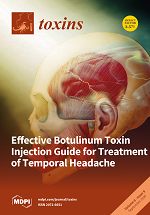Due to unavoidable contaminations in feedstuff, pigs are easily exposed to aflatoxin B
1 (AFB
1) and suffer from poisoning, thus the poisoned products potentially affect human health. Heretofore, the metabolic process of AFB
1 in pigs remains to be clarified, especially
[...] Read more.
Due to unavoidable contaminations in feedstuff, pigs are easily exposed to aflatoxin B
1 (AFB
1) and suffer from poisoning, thus the poisoned products potentially affect human health. Heretofore, the metabolic process of AFB
1 in pigs remains to be clarified, especially the principal cytochrome P450 oxidases responsible for its activation. In this study, we cloned CYP3A29 from pig liver and expressed it in
Escherichia coli, and its activity has been confirmed with the typical P450 CO-reduced spectral characteristic and nifedipine-oxidizing activity. The reconstituted membrane incubation proved that the recombinant CYP3A29 was able to oxidize AFB
1 to form AFB
1-exo-8,9-epoxide in vitro. The structural basis for the regioselective epoxidation of AFB
1 by CYP3A29 was further addressed. The T309A mutation significantly decreased the production of AFBO, whereas F304A exhibited an enhanced activation towards AFB
1. In agreement with the mutagenesis study, the molecular docking simulation suggested that Thr309 played a significant role in stabilization of AFB
1 binding in the active center through a hydrogen bond. In addition, the bulk phenyl group of Phe304 potentially imposed steric hindrance on the binding of AFB
1. Our study demonstrates the bioactivation of pig CYP3A29 towards AFB
1 in vitro, and provides the insight for understanding regioselectivity of CYP3A29 to AFB
1.
Full article






